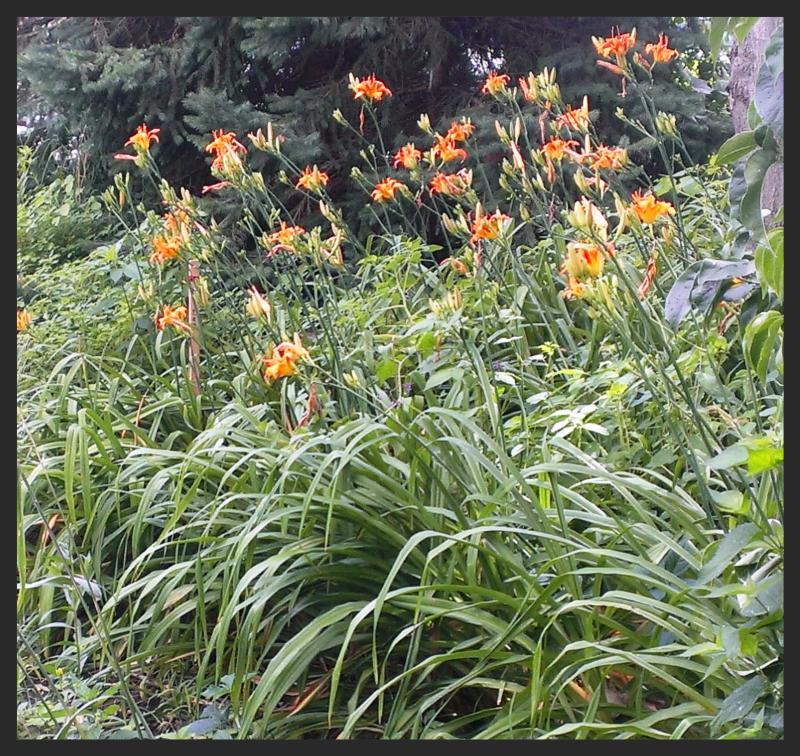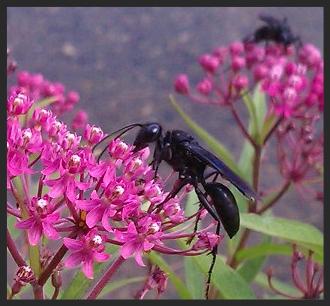|
November Article
|
Do we cut it down or leave it stand?

Ah, fall is really here! Leaves are getting raked, football is in full swing, and the imminent first snow is just around the corner. So what do we do with our restoration areas - our shore buffers, prairies, and native gardens? While we might be tempted to cut everything down and rake it off the land like we do with our tree's leaves, there are many benefits to leaving our natural areas standing through the winter.
 Native vegetation is extremely important for wildlife this
time of year, as they fatten up and hunker down for the long winter ahead. Many pollinators like bees and butterflies use the leaf litter or hollow stems in our restorations to build nests to last the winter. Ducks, geese, swans, and other migratory birds flying south this season also use our restorations as way stations for food and shelter. Small mammals like rabbits, mice, and voles also use the grassy vegetation for cover to survive predation.
Native vegetation is extremely important for wildlife this
time of year, as they fatten up and hunker down for the long winter ahead. Many pollinators like bees and butterflies use the leaf litter or hollow stems in our restorations to build nests to last the winter. Ducks, geese, swans, and other migratory birds flying south this season also use our restorations as way stations for food and shelter. Small mammals like rabbits, mice, and voles also use the grassy vegetation for cover to survive predation.
 Leaving last season's vegetation up has great aesthetic value as well. Soon the long winter months will look like a barren white landscape and we will long for the days of colorful foliage. Grasses like little bluestem or Indian grass provide beautiful copper and red colors all winter long. Old flower stems add visual interest to an otherwise bleak landscape, especially when it snows or ice forms on the old flower heads.
Speaking of snow, it will soon start
falling whether we like it or not. Unlike turf grass that has short root systems, native grass and plant roots grow deep into the soil. These deep roots increase water infiltration into the soil. This means that instead of snow melt flowing off your property, it is able to travel deep into the ground. This helps to reduce soil erosion, decreases nutrient flow in our surface waters, and replenish groundwater.

Native plant systems are great at holding together steep banks of hillsides and lakeshores. Ice heave is a natural disturbance on our shores in Minnesota. One of the best ways to combat ice heave is to have a natural shore. Leaving a natural shore alone in the fall provides another level of protection against ice heave. Every little bit helps against this powerful force of nature.
We have heard a lot of

talk about carbon budgets and
carbon footprints recently. Well, your natural areas and how you manage them helps to reduce your carbon footprint. A diversity of native plants grabs carbon dioxide from the atmosphere. Also, keeping a natural buffer up in the fall works to trap leaves and other organic matter; this area of your yard then becomes a carbon and nutrient sink. Keeping this organic material on site, instead of moving it off site helps you to do your part in creating an effective carbon sink.
 So why is it so difficult just to leave our natural areas alone at the end of the growing season? Well, wanting a neat and tidy property has been a part of our Midwestern upbringing. I fondly remember helping my parents cut and rake leaves in the fall so that we were ready for winter. It's just part of being a Minnesotan. So having that "wild look" is sometimes hard to accept, but the benefits are so great that it's worth changing this traditional behavior to become better stewards of our land. Still having trouble breaking away from tradition? So why is it so difficult just to leave our natural areas alone at the end of the growing season? Well, wanting a neat and tidy property has been a part of our Midwestern upbringing. I fondly remember helping my parents cut and rake leaves in the fall so that we were ready for winter. It's just part of being a Minnesotan. So having that "wild look" is sometimes hard to accept, but the benefits are so great that it's worth changing this traditional behavior to become better stewards of our land. Still having trouble breaking away from tradition?
Try these techniques:
- Start by leaving a small portion of your restoration up all winter.
- Mow it down but leave the debris on-site for habitat.
- Rake some debris out but intentionally keep some hollowed out stems or a pile of leaves for pollinators.
|
|
Native Plant of the Month
|

Thimbleweed
Anemone virginiana
Moisture: Moist or Dry
Exposure: Part Shade or Sun
Color: White
Bloom: June to July
Height: 1-2
Feet
A summer-blooming white flower that sits on stems that are hairy and purplish at the base. Thimbleweed leaves are trifoliate, toothed, and hairy. They have a single flower terminal on their stalk with 2 to 3 or more flowers per plant. Their green fruit is long and cylindrical, resembling a thimble (giving it the name Thimbleweed). The seed head ripens into a fluffy "cottony" mass in the fall. Thimbleweed grows in dry, open woods, and clearings. These prairie plants tolerate drought well. Bees and small flies visit their flowers for pollen. Native Americans used them for medicine. Another common name is tall anemone.
|
|
Invasive Plant of the Month
|
Orange Daylily 
Hemerocallis fulva
Exposure: Part Shade or Sun
Moisture: Dry to moist
Height: 2-5 Feet
Blooms: June-August
An invasive but popular garden plant from Asia, Daylilies are often found along roadsides and creek beds, out-competing native plants. Flowers are three inches wide with 3 petals and 3 sepals. They are orange with yellow stripes doing down into the flower. They are named daylilies because the flower will only last one day. Each plant can have a few flowering stems that come from a base of narrow leaves. The leaves are 1-3 feet long and about an inch and a half thick. Management strategies include multiple herbicide treatments or manually digging out small patches. However, when digging out plants make sure all pieces of the tuber is removed or it will return.
|
Great Black Wasp
Sphex penslyvanicus
Range
: Most of North America
Habitat
: open gardens, parks, fields, and wetlands.
Identification
: A species of Digger Wasp, the Great Black Wasp, is a solitary wasp that builds a ground nest. These sheltered burrows are about a foot deep and in soft soils. It grows between 1 and 1.5 inches long and is all black with iridescent wings. Adult wasps feed on nectar while the larvae are fed paralyzed katydids and grasshoppers by the female. This wasp can sting but is rarely aggressive towards humans unless persistently provoked.
Pollination
: Great Black Wasps regularly visit Rattlesnake Master, Bergamot, Horsemint, Virginia Mountain Mint, Milkweed Species, and many more!
|
|
|
Our retail nursery is currently closed for the season. For 2016 orders, email Jill at [email protected]
Click and visit our website for current
|
|
|